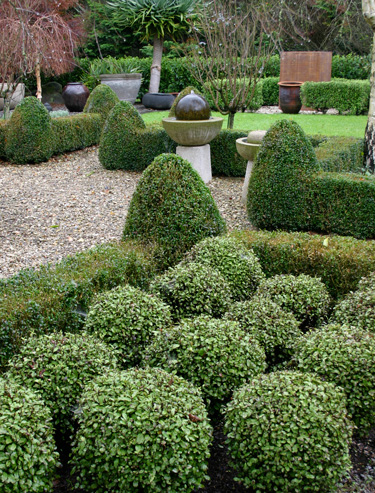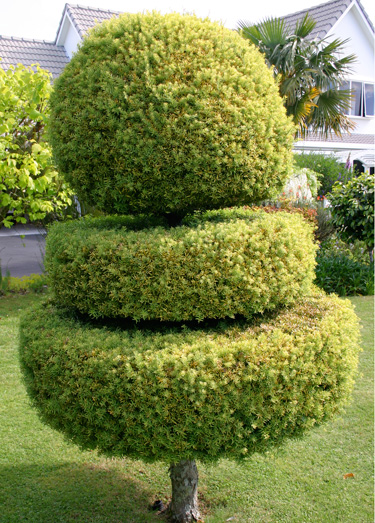Living art
When an evergreen shrub is sculpted into an interesting or architectural shape, it takes on the role of a garden statue, a focal point or accent amid the free flow forms of grasses or perennials. In the middle of winter, an evergreen can create a real point of interest while flowers are sleeping.
Topiary is an age-old art reminiscent of grand formal gardens. But it has a place in any style or size of garden. Start with simple shapes like balls, cubes or cones. Even simpler, the dome shape is one of the most appealing of all and there is no need to be perfectly symmetrical. Japanese topiaries, for example are deliberately informal, echoing the shapes of rocks, hills and mountains. You might also practice by making baby topiaries in pots, which make great table pieces.
The best topiary plants have small leaves packed closely on a tight bushy branch structure. There are plenty of quick growing topiaries for fast results, but slower growing topiaries live longer and demand less upkeep. One of the reasons English box is so popular is that, while by no means the quickest grower, it is relatively quick and its growth remains tight even when not trimmed, so it’s a very forgiving topiary plant. There are lots of exciting alternatives to English box, including many New Zealand natives.
PLANTS FOR TOPIARY |
|
|
| Buxus cultivars | Box | The favourite |
| Camellia cultivars | Camellia | Choose smaller leaf forms |
| Coprosma cultivars | NZ coprosmas | Choose small leaf forms |
| Corokia cultivars | NZ corokias | Attractive foliage colours |
| Ilex | Holly | Good in cold climates |
| Junierus ‘Kaizuka’ | Hollywood juniper | Slow growth, great for spirals |
| Lonicera nitida | Box honeysuckle | Fast growing but short lived |
| Michelias | Michelia, Fairy Magnolia | Glossy leaves |
| Myrtus ugni | Chilean guava | Trim often for compact growth |
| Picea glauca ‘Conica’ | Dwarf Alberta spruce | A natural cone shape |
| Pittosporum ‘Golf Ball’ | Dwarf pittosporum | Natural ball shape growth |
| Podocarpus cultivars | Totara | Cold hardy |
| Syzygium australe cultivars | Lilly Pilly | Quick growing. Choose small leaf cultivars |
| Taxus | Yew | Slow growing |
| Tuecrium fruticans | Silver germander | Very quick growing. Needs trimming often |
| Westringia cultivars | Aussie box | Attractive grey foliage |
Simple shapes to try
Spheres are easy on the eye and look wonderful in pots. They require a good eye to get perfectly symmetrical, but you can make yourself a wire circle to use as a guide. A smooth symmetrical result its easiest to achieve when you choose a small leaf shrub and trim often.
Lollipop topiaries look great in pots. For a sphere on a stick, choose a single ‘trunk’ and keep it upright by tying it to a stake. Remove the side shoots as the shrub grows then shape the top when it reaches the desired height. Good for lollipops: Buxus, Corokia, Syzygium, Camellia, Michelia, Laurus (bay tree).
Tiers are great if you want to impress without stress, because they’re surprisingly forgiving of imperfect symmetry. You can build up a stack of 3D shapes as the plant grows or sculpt a mature shrub into a series of tiers, by clearing sections of the trunk. Good for tiers: Totara, juniper and other conifers.
Cones and pyramids are easiest to maintain if you start with a plant whose growth habit is naturally conical. Then it’s just a matter of exaggerating the natural shape. Good for cones: Buxus, Corokia, Picea Coprosma ‘Cappucchino’.
Cubes need a keen eye and sharp blade, and regular trimming. String lines and stakes are helpful if you’re aiming for perfection. Good for cubes: Buxus, Syzygium, Lonicera, Teucrium, Westringa.
The spiral takes patience but is one of the loveliest forms of all. Start with a strong upright plant attached to a stake. Trim the side growth to encourage straight upright growth, but delay trimming the spiral shape until the plant has reached about 1.2m tall. Good for spirals: Buxus, Corokia, Hollywood juniper.
Topiary Tips
- Keep tools clean and sharp. For best results use secateurs or a good pair of scissors. If you have lots of topiary, electric hedge shears, though not as accurate for the beginner, save time.
- Plant in autumn or winter but wait till spring for the first trim.
- Start with an all-over trim after the last spring frost, then as often as necessary through till the end of summer to keep your topiary tidy.
- Clip little and often. Regular clipping of young growth keeps edges neat and growth tight.
- Stop clipping in early autumn to avoid stimulating new growth sensitive to frost.
- Step back frequently as you snip, assessing your work from all sides. Proceed with caution. An error can take a long time to grow back!
- Use wire templates or string as a guide for straight edges.
- Lay a sheet of plastic on the ground to collect the trimmings.
- Water regularly (especially pots) and feed sparingly. Too much fertiliser promotes excessive growth. For topiaries in pots use controlled release fertiliser in spring.
14-Mar-2016


Golden totara tiers

Corokia Frosted Chocolate spiral

Trimmed domes of Irish Yew


